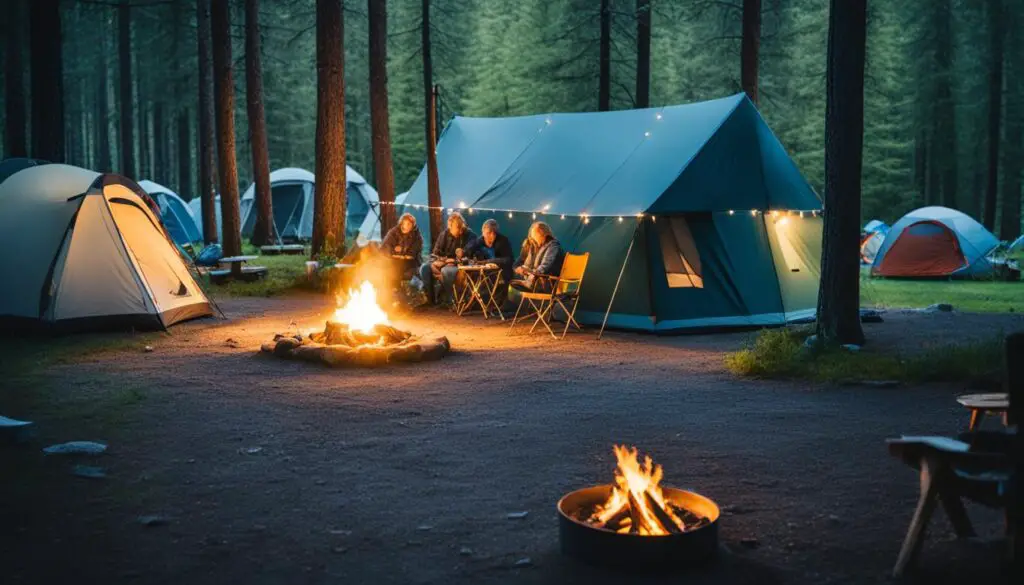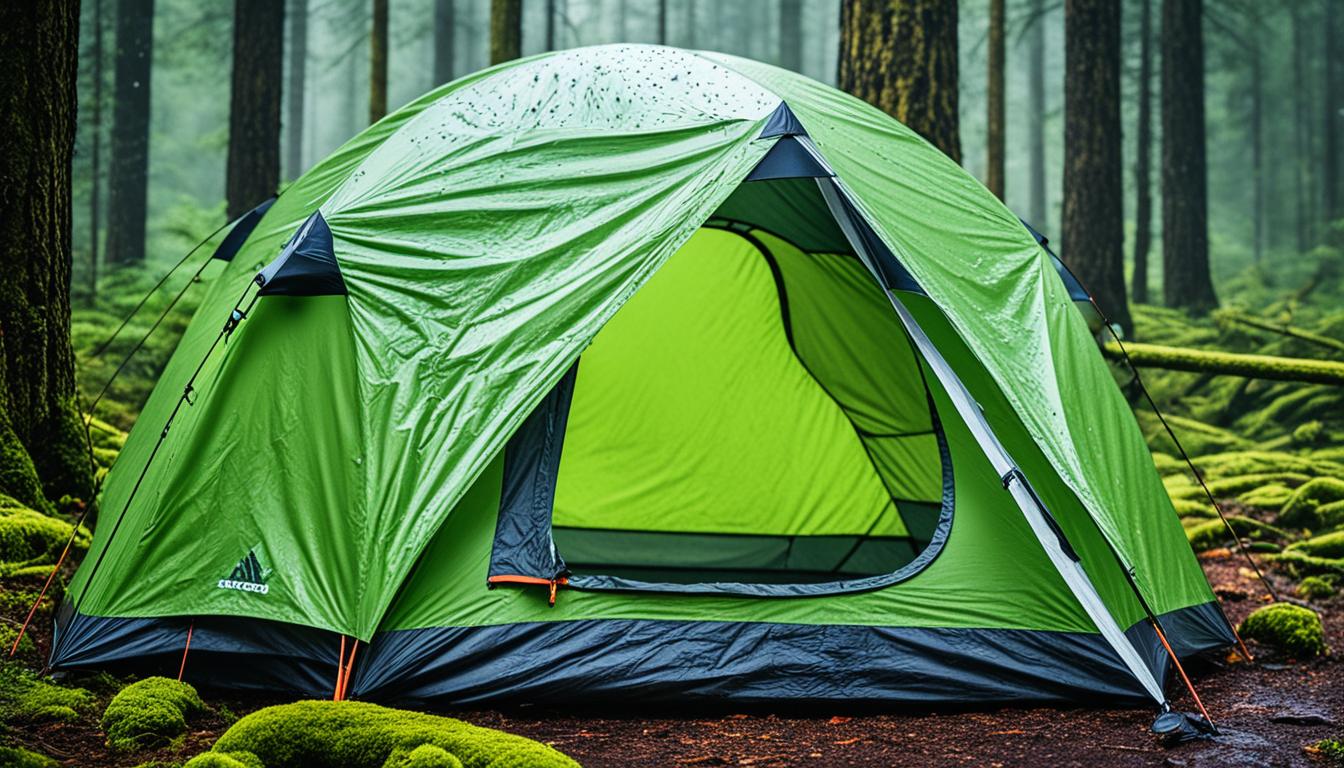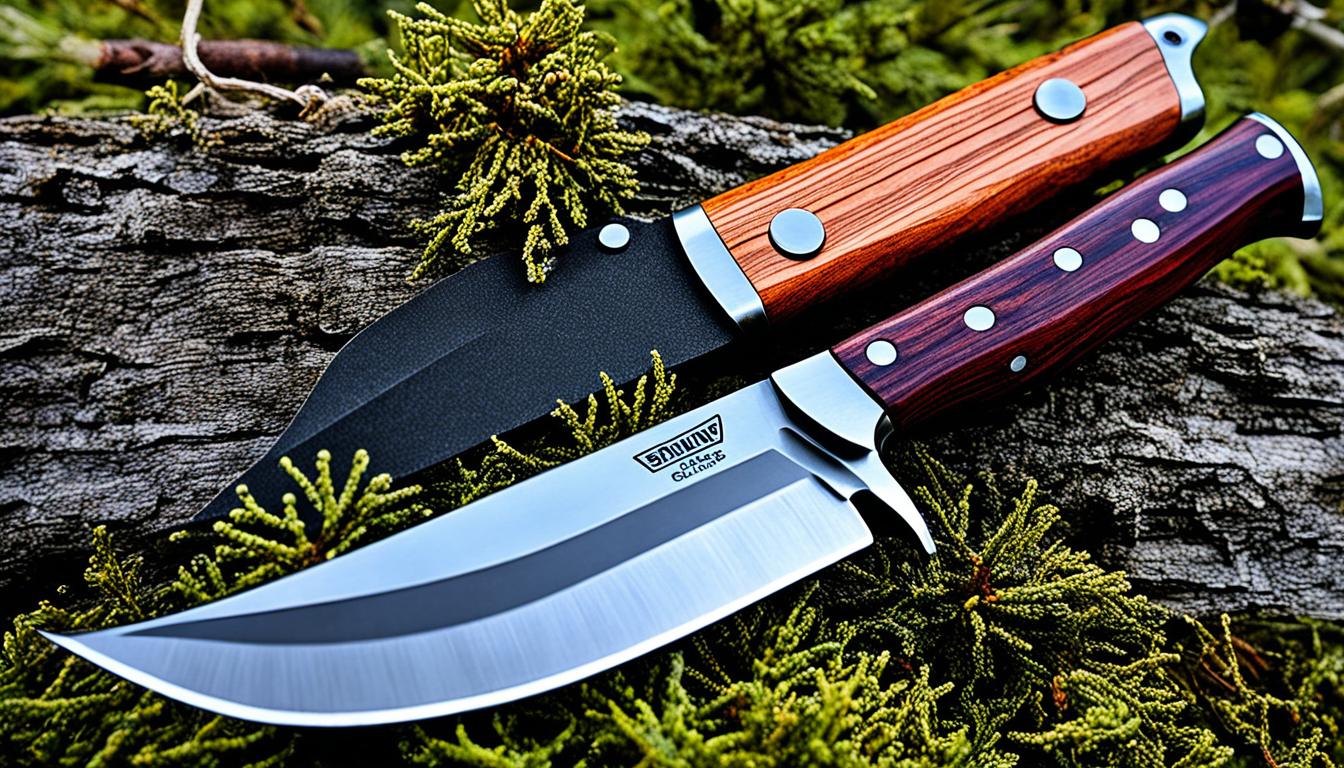
I love the outdoors and have explored it a lot. I’ve hiked in the mountains and slept under the stars. The terms “campsite” and “camping” might seem similar. However, they mean different things that can change how you enjoy the outdoors. In this piece, I’ll share the main differences between a campsite and camping. This will help you see the key parts of outdoor fun.
Defining Campsite and Camping
Outdoor fans often mix “campsite” and “camping” up, but they really talk about different things. Knowing what each means helps you plan your outdoor fun better.
Campsite: A Designated Outdoor Space
A campsite means a special outdoor spot for staying the night. It usually has a spot for your tent, water nearby, and sometimes fun extras like picnic tables or fire pits. You can find campsites in places like national parks, state parks, or private spots. They aim to make overnight stays easy and enjoyable.
Camping: The Act of Staying Outdoors
Camping means spending the night in the open air. This could be at a special campsite or out in wilder areas. You might sleep in a tent, under the stars, or in an RV. But no matter how you camp, it’s about enjoying nature and taking a break from daily worries.
So, a campsite is where camping happens, while camping is the fun of being outside, usually at night. It’s good to know the difference. It can help you get ready for your next adventure.
What Is the Difference Between Campsite and Camping?
A campsite and camping are different but connected. A campsite is a place with spaces set up for you to stay overnight outdoors. It has things like toilets, places to cook, and clean water. Camping is the actual staying overnight in nature, whether at a campsite or somewhere wild.
Let’s look closer at what a campsite is and what camping means:
Campsites: The Designated Outdoor Spaces
A campsite is a special area for staying overnight outdoors. It’s got everything you need to be comfortable. This might be flat ground to set up a tent, clean water, toilets, picnic tables, and a place for a fire. It also has parking and spots for your trash.
Camping: The Outdoor Experience
Camping is all about being outside and sleeping in a tent for fun or relaxation. It can happen in many places, like:
- Places set up for camping with toilets and more
- Untouched nature, far from cities and roads
- Your own yard or far places without campsites
Camping is the fun part, while a campsite is the place with stuff like toilets and water to help you have a good time. But, you can camp in any outdoor place, whether it’s official or not.
To sum up, a campsite is a special space outdoors with all the things you need. Camping is the adventure of sleeping outside. This can be done in a formal campsite or out in the wild.
Types of Campsites
Campsites can be put into two kinds. There are developed campsites and primitive campsites. Both types of sites offer different experiences for people who love the outdoors.
Developed Campsites
Developed campsites are sturdy and well-stocked for a pleasant stay. They come with useful things like bathrooms, water, power, and sometimes Wi-Fi. These campsites are usually found in popular spots and are great for families and people who like more comfort when camping.
Primitive Campsites
On the other hand, primitive campsites are places where you really get into nature. They don’t have many facilities. This makes campers rely on themselves more and enjoy a simpler way of life. These campsites can be far out in nature, letting visitors escape the noise of daily life and get closer to the earth.
The decision between these two types of campsites depends on your camping style. Developed campsites are good for those who want convenience. Primitive campsites are better for those seeking a deep, outdoor adventure. In the end, both types offer great opportunities to enjoy nature and make lasting memories.
Camping Styles and Experiences
Finding the right camping styles and camping experiences means choosing the best campsite. You might like the comfy, well-equipped areas of a developed site. Or maybe you enjoy the more adventurous, off-the-grid feel of a primitive one. Each type has something unique to offer for outdoor recreation that fits differently with what you want and need.
Developed campsites are great for families, groups, or if you like comfort. With running water, flush toilets, and sometimes power, these sites keep you connected while you enjoy nature. They’re also laid out well and have plenty of room for fun and meeting new people. This creates an adventure travel feel for your stay.
On the other hand, if you’re into a true outdoor adventure, primitive campsites are the way to go. These sites are usually far from others, with few to no extras. Here, you can really get away from daily life’s noise and stress. The wild, simple areas help you feel more at one with nature and more independent. They’re just what you need for quiet, solo camping or camping styles that focus on being in the true, untouched wilderness.
The best choice between a developed or primitive site depends on what you prefer. It’s about the type of camping experiences you want and what you hope to get out of your outdoor escape. If you’re after modern perks, or if you crave pure nature, there’s a camping style waiting for you.

Essential Gear for Camping
Camping brings us closer to nature and lets us make great memories. To stay comfortable and safe, the right camping gear and camping equipment are a must. For short trips or longer ones, having the proper outdoor gear, hiking gear, and survival gear is essential.
Shelter and Sleep Systems
A solid shelter and sleep setup is key for any camping adventure. You need a tough tent against the weather, a warm sleeping bag, and a comfy sleeping pad for the ground.
- Tent: Pick a tent that fits the number of people and the expected weather.
- Sleeping Bag: Choose a bag that’s right for the weather where you’ll camp.
- Sleeping Pad: Go for a self-inflating or foam pad for a better night’s sleep.
Cooking and Food Storage
Eating well is important for a fun camping time. The right cooking and food storage gear keeps you happy and energized.
- Camp Stove: You’ll need a reliable stove for cooking meals and heating drinks.
- Cooler: A good cooler keeps food fresh and drinks cold.
- Utensils: Don’t forget sturdy cooking tools for easy meal prep.
| Camping Gear | Purpose | Key Considerations |
|---|---|---|
| Tent | Provides shelter and protection from the elements | Size, weather resistance, easy setup |
| Sleeping Bag | Keeps you warm and comfortable during the night | Rating, material, and pack size |
| Camp Stove | For cooking meals and boiling water | Fuel, heat, and user-friendliness |
| Cooler | Keeps food fresh and drinks cold | Size, insulation, and durability |
Choosing the right camping gear ensures your trip is enjoyable and safe. Think about what you need for your adventure before picking your gear. This includes considering the trip’s needs and the environment.
Choosing the Right Campsite
Picking the right campsite is key for a comfy and safe trip. It’s important to think about the location and what’s there. These things really affect your time outside. Let’s look at what to keep in mind for the best campsite.
Location and Amenities
The place your campsite is matters a lot. Being close to water is great for drinking and fun. Easy access is a must, making it simple to get to your campsite.
Rules like fire pits, picnic tables, and bathrooms can improve your stay. They make everything more comfortable. So, you can really enjoy the nature around you.
Safety Considerations
When picking a campsite, safety comes first. Stay away from areas with too many animals, or where natural disasters might happen. This keeps you and your group safe.
Check if the ground is flat and safe for sleeping. Also, pick a spot away from trees that look like they might fall. All this helps keep you out of harm’s way.
Think about where you’re camping, what it offers, and how safe it is. These steps help you find a campsite that sticks in your memory. The perfect campsite can change everything for the better.
Leave No Trace Principles
Outdoor enthusiasts, it’s time to learn about the essential leave no trace principles. They are important for ethical and sustainable camping. We must reduce our impact and protect nature’s beauty for the future.
There are seven core tenets of leave no trace. These guide us in showing deep environmental stewardship. They make our outdoor adventures good for the environment.
- Plan Ahead and Prepare: Planning well helps reduce our impact. Know your destination, pack right, and follow the local rules.
- Travel and Camp on Durable Surfaces: Stick to the paths and campgrounds to protect nature. Spread out in some areas to keep trails from forming.
- Dispose of Waste Properly: Take all trash, even small items, with you. Handle human waste and toilet paper properly.
- Leave What You Find: Don’t pick or move anything from its natural spot. Leave nature as you found it.
- Minimize Campfire Impacts: Prefer a stove for cooking. For fires, keep them small and don’t leave until they are out.
- Respect Wildlife: Keep a safe distance from animals and don’t feed them. Store food well to keep them away.
- Be Considerate of Other Visitors: Be quiet and respect other people’s space. Enjoy the outdoor with others’ comfort in mind.
By following the leave no trace principles, we build a sustainable culture. We ensure our trips have a positive, lasting impact on nature. Let’s travel with respect and a strong commitment to protecting our wilderness.
Conclusion
So, what’s the difference between a campsite and camping? A campsite is a specific outdoor spot. Camping, on the other hand, is spending the night in nature. Knowing this helps people pick the perfect place for their outdoorsy trip.
Do you like the ease of a developed campsite or the raw beauty of camping in a simple spot? With the right equipment and by following nature-friendly rules, your camping journey will be great. Get ready to see the wonders of the wild and have amazing adventures.
Whether you love peace in a far-off campsite or the fun of a busy one, camping has something for everyone. It’s about campsite vs camping, outdoor recreation, nature exploration, and useful travel tips. No matter if you’re experienced outdoors or just starting, there’s plenty to enjoy out there.
FAQ
What is the difference between a campsite and camping?
A campsite is a specific place outdoors, while camping means spending the night in nature. Campsites have what you need for camping. But you can also camp in places without these facilities.
What are the types of campsites?
There are two main types of campsites. Developed campsites have many amenities like bathrooms, water, and power. Primitive campsites are basic and often in wild, remote areas.
How do camping styles and experiences differ?
The site you pick changes your camping adventure. Developed sites are good for families and have some comforts. Primitive sites offer a deeper wild experience. The location and features of a site affect the vibe of the trip.
What are the essential gear items for camping?
Every camper needs key items for comfort and safety. These include tents, sleeping bags, and cooking equipment. Picking the right gear improves your camping experience.
How do I choose the right campsite?
Choosing the right campsite is crucial for a good trip. Think about water, ease of getting there, and what facilities are available. Also, pick a safe spot away from dangers like wildlife.
What are the Leave No Trace principles?
It’s important to follow the Leave No Trace rules. They help us camp responsibly. This includes cleaning up, being kind to animals, and caring for nature. By following these rules, we help save the planet for future campers.
- Discover the 4 Must-Have Camping Tent Accessories for Spring 2025 - March 19, 2025
- Why Camping Is Bad - November 29, 2024
- Best Camping Knife - November 29, 2024






